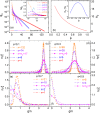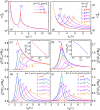Theory of relaxor-ferroelectricity
- PMID: 32193443
- PMCID: PMC7081360
- DOI: 10.1038/s41598-020-61911-5
Theory of relaxor-ferroelectricity
Abstract
Relaxor-ferroelectrics are fascinating and useful materials, but the mechanism of relaxor-ferroelectricity has been puzzling the scientific community for more than 65 years. Here, a theory of relaxor-ferroelectricity is presented based on 3-dimensional-extended-random-site-Ising-model along with Glauber-dynamics of pseudospins. We propose a new mean-field of pseudospin-strings to solve this kinetic model. The theoretical results show that, with decreasing pseudospin concentration, there are evolutions from normal-ferroelectrics to relaxor-ferroelectrics to paraelectrics, especially indicating by the crossovers from, (a) the sharp to diffuse change at the phase-transition temperature to disappearance in the whole temperature range of order-parameter, and (b) the power-law to Vogel-Fulcher-law to Arrhenius-relation of the average relaxation time. Particularly, the calculated local-order-parameter of the relaxor-ferroelectrics gives the polar-nano-regions appearing far above the diffuse-phase-transition and shows the quasi-fractal characteristic near and below the transition temperature. We also provide a new mechanism of Burns-transformation which stems from not only the polar-nano-regions but also the correlation-function between pseudospins, and put forward a definition of the canonical relaxor-ferroelectrics. The theory accounts for the main facts of relaxor-ferroelectricity, and in addition gives a good quantitative agreement with the experimental results of the order-parameter, specific-heat, high-frequency permittivity, and Burns-transformation of lead magnesium niobate, the canonical relaxor-ferroelectric.
Conflict of interest statement
The authors declare no competing interests.
Figures








References
-
- Smolenskii GA, Rozgachev KI. Segnetoelektricheskie svoistva tverdykh rastvorov v sisteme titanat bariya titanat strontsiya. Z. Tekhn. Fiz. 1954;24:1751–1760.
-
- Smolenskii GA, Agranovskaya AI. Dielectric polarization of a number of complex compounds. Sov. Phys. Sol. Stat. 1960;1:1429–1437.
-
- Kleemann W, Kloessner A. Glassy and domain states in random dipolar systems. Ferroelectrics. 1993;150:35–45. doi: 10.1080/00150199308008692. - DOI
-
- Viehland D, Jang SJ, Cross LE, Wuttig M. Freezing of the polarization fluctuations in lead magnesium niobate relaxors. J. Appl. Phys. 1990;68:2916–2921. doi: 10.1063/1.346425. - DOI
LinkOut - more resources
Full Text Sources

